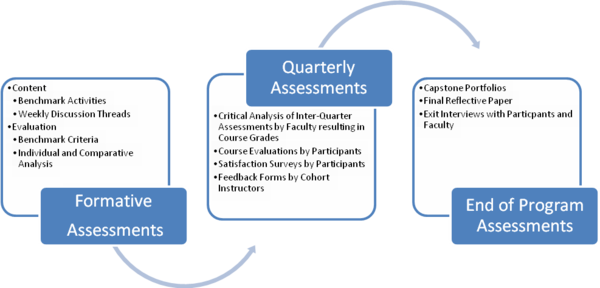| << Chapter < Page | Chapter >> Page > |
The online program took our program evaluation data a step further by enabling more frequent data collection and, we believe, better continued connections with participants after graduation. Figure 1 illustrates the major components of the multi-dimensional assessment plan for the blended online program and the continuous growth nature of participant and program evaluation.

A mixed-methods analysis of program integrity was conducted to compare the university-district and blended online cohorts. A one-way ANOVA was conducted among three cohorts to compare any significant differences in program outcomes based on student end of course evaluations. Next, the voices of blended online program participants, cohort instructors and course professors have been gathered as the program has developed. The implications of end of course program evaluations suggest that the core program values were maintained in the transformation of the program from ground to distance. The richness of the program impact are discussed and presented through participants’ voices via qualitative inquiry. The following themes emerged through a comparison of these qualitative data: acquisition of a leadership lens and persona, comfort with ambiguity, reflective and critical thinking, and knowledge of systems and the capacity to analyze data and diagnose organization.
The end of quarter course evaluations from Fall 2010 for three cohorts with a sample size of 44 was evaluated using a one-way ANOVA. ANOVA results revealed 9% or one out of the eleven question had a p-value<.05; indicating a significant difference between the groups. The question: (1) I found course objectives and assignments to be clearly stated and easily understood, with a p-value<.05; F(2, 41) = 4.33, p<.05 indicated a strong difference between groups. Follow-up analysis of this difference reveals a consistent outcome for university-district cohorts with a significantly lower mean for the blended online cohort. These results may be attributable to the dual learning curve incumbent upon the blended online cohort students. Not only were students introduced to an innovative, field-based program (tending to differ vastly from the pedagogy of their previous educational experiences) but they were also expected to adapt to distance learning environment. The majority of students had no experience with online or distance learning prior to their enrollment in this program. It will be possible to test this hypothesis with continued evaluation of student learning outcomes across all three programs.
The ten remaining questions had a p-value>.05 indicating no significant difference between the groups. Two questions showed unusually high fidelity among the three cohorts: (2) I was engaged with the content and material being studied in the course and (5) The way in which this course was taught required me to think in new and different ways . The impact of the courses on students’ perception of engagement and their thinking provides initial evidence that the result of the transformative pedagogy is consistent across delivery models.

Notification Switch
Would you like to follow the 'Ncpea handbook of online instruction and programs in education leadership' conversation and receive update notifications?